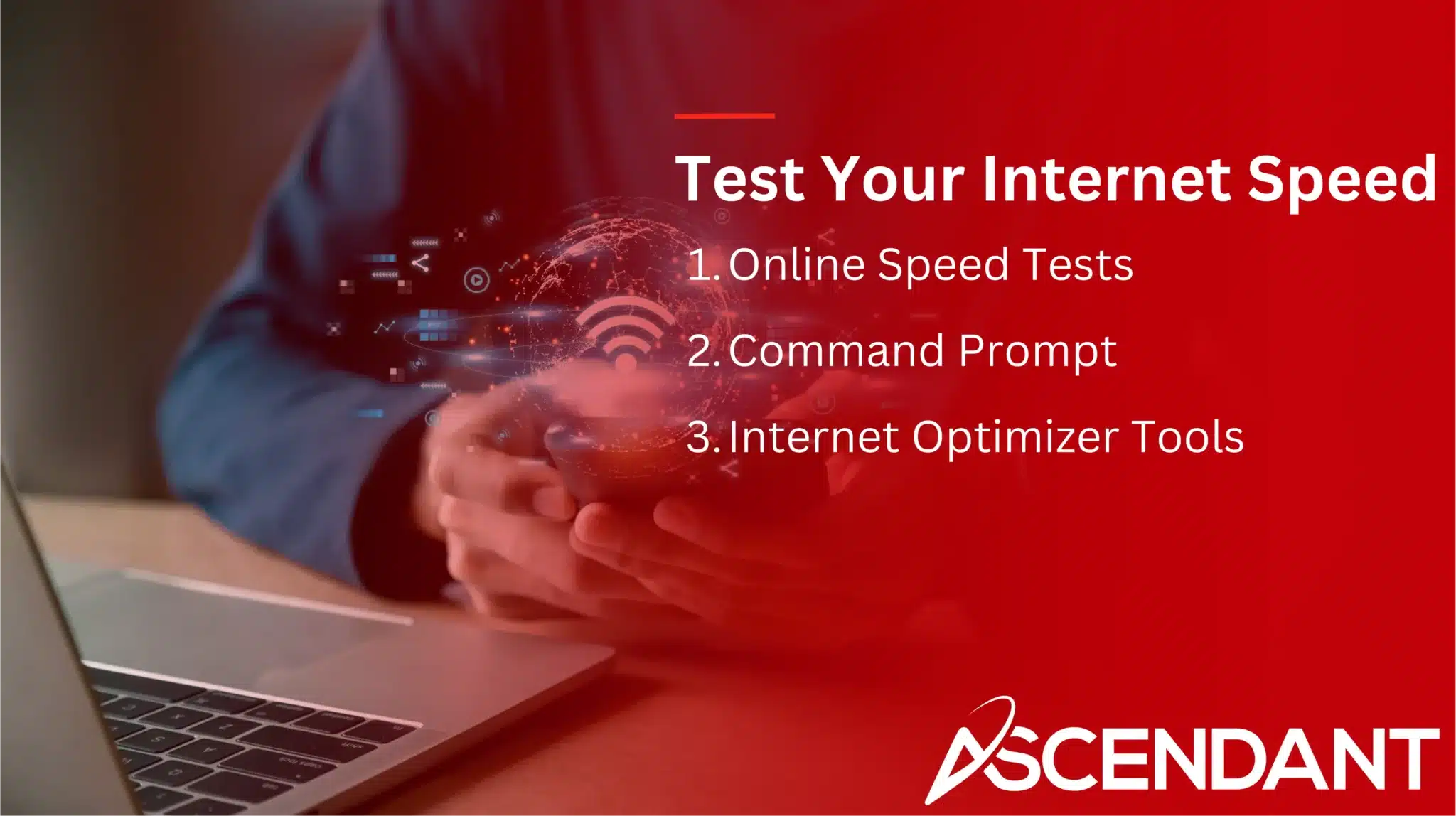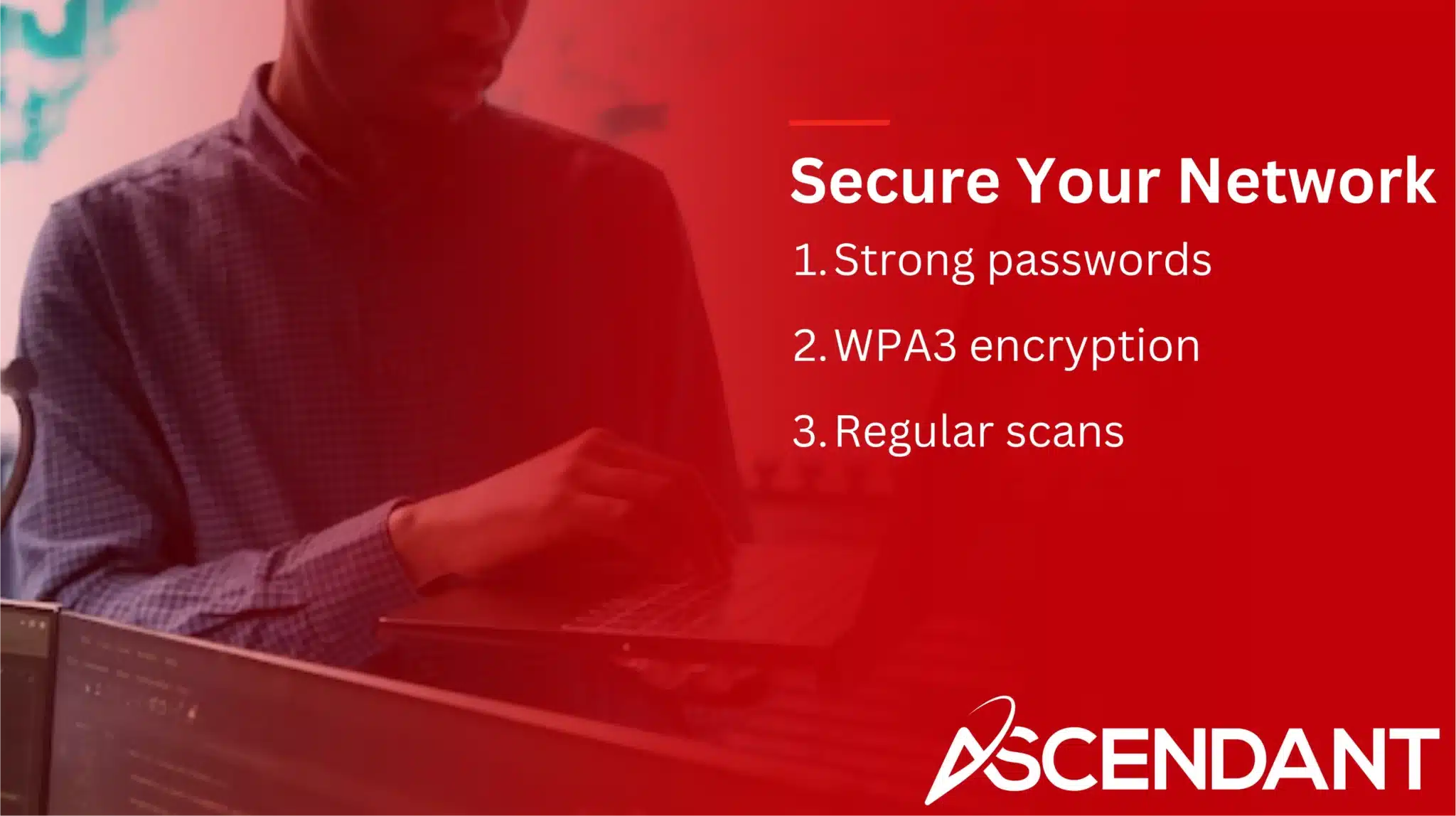Struggling with slow internet? Learn how to increase internet speed with practical tips. This guide covers diagnosing speed issues, optimizing equipment, and managing devices to boost your connection.
In This Article:
- Identify the Causes of Slow Internet
- Test Your Internet Speed
- Optimize Your Router Placement
- Update Your Equipment and Software
- Secure Your Network
- Manage Connected Devices
- Use Wired Connections
- Enhance Wi-Fi Signal Strength
- Optimize Browser and App Settings
- Consider Upgrading Your Internet Plan
Key Takeaways
- Identify slow internet causes such as network congestion, outdated equipment, and physical obstacles to improve performance.
- Test your internet speed regularly using online tools, and utilize network diagnostics tools like Command Prompt for troubleshooting.
- Optimize your router placement, secure your network, manage connected devices, and consider upgrading to a faster internet plan for better connectivity.
Identify the Causes of Slow Internet
Before tackling the issue of a slow internet connection, it’s essential to pinpoint the underlying reasons. Slow internet speeds can be attributed to a variety of factors including network congestion, use of obsolete hardware, and physical obstructions. Recognizing these contributing elements is imperative for addressing them effectively and enhancing your overall internet performance.
Network congestion
When numerous devices tap into the same Wi-Fi network, internet performance can degrade due to increased traffic leading to reduced internet speeds. As more devices engage in activities like streaming videos, engaging in online games, or downloading content all at once on a single network, you may notice a notable decline in connection speed. To maintain optimal internet performance, it’s crucial to manage both the quantity of connected devices and how they are used.
To mitigate network congestion and enhance your Wi-Fi speed, consider disconnecting gadgets that aren’t currently needed. Arranging data-intensive tasks for times when fewer people are using the internet could contribute to an uptick in your connection stability and overall Internet speed.
Outdated equipment
Outdated routers or modems may cause a decline in internet speed for connected devices across the network. To determine your device’s maximum supported speed, consult the owner’s manual or look it up online.
Investing in contemporary hardware can greatly enhance your internet speeds and improve overall network performance.
Physical interference
Wi-Fi speeds can be hindered by physical obstructions like walls and appliances. The performance of Wi-Fi can suffer as more devices are connected to it. The potency of wireless signals is often diminished by barriers such as walls and floors. Fixtures such as furniture and household gadgets—especially cordless phones and microwave ovens—have a tendency to soak up router signals, leading to a decline in internet speed.
By placing your router thoughtfully within your space, you can lessen the impact that these physical impediments have on your Wi-Fi signal.
Test Your Internet Speed
Regularly checking your internet speed is crucial for gauging the quality of your connection and pinpointing any problems. It assists in ascertaining if issues originate from your internet service provider or are due to the configuration of your home network setup.
Online speed tests
Online speed tests are a reliable method for gauging your internet connection’s performance. By accessing a website like speedtest.net, you can easily initiate the test by selecting GO and measure both download and upload speeds of your network. It is essential to periodically check your internet speeds to ensure that the quality of your connection aligns with what was promised by your Internet Service Provider (ISP).
Should you discover that your internet speeds are suboptimal, it may be time to consider taking steps toward enhancement. Sometimes, simply restarting the router can lead to an improved connection. Experimenting with different locations for the router might reveal areas within which connectivity is weak—knowledge that could prove useful when making adjustments aimed at optimizing overall internet performance.
Command Prompt
The Command Prompt in Windows serves as a potent instrument for diagnosing network performance issues, including those related to connectivity. Utilizing the capabilities of the Command Prompt can assist users in pinpointing and resolving problems with their network connection.
By employing the tracert command within the Command Prompt, individuals have the ability to obtain an understanding of network latency which plays a significant role in determining connection speeds. This command provides visibility into the journey that data takes from one’s personal computer to a specific server by revealing any potential hold-ups encountered along this path.
Internet Optimizer tools
The Internet Optimizer from Auslogics BoostSpeed is crafted to enhance your internet speed and boost the performance of your system. By displaying your internet speed, it effectively optimizes data accessibility, functioning as an accelerator for your online connectivity.
These kinds of tools are essential when it comes to identifying and addressing problems that could be causing a lag in your internet connection.
Optimize Your Router Placement
Placing your router in an optimal location is crucial for enhancing the strength of your Wi-Fi signal and boosting your internet speed, which can lead to a more stable and robust connection across your living space.
Central location
To enhance Wi-Fi coverage, it’s best to position the router in a central location within your home. By doing so, the Wi-Fi signal is more likely to effectively cover all parts of your residence, thereby minimizing dead zones and elevating the quality of your connection.
Avoid obstructions
It is essential to position the router at a distance from metal objects in order to preserve a strong Wi-Fi signal. The presence of metal can drastically disrupt the Wi-Fi signal, leading to decreased internet speeds and problems with connecting.
Walls and other barriers should also be avoided when placing your router. This helps maintain optimal strength for your Wi-Fi signal.
Adjust antennas
Explore various configurations of antenna orientation to maximize signal strength. Adjusting antennas to both vertical and horizontal alignments may boost the Wi-Fi signal. Experiment with diverse arrangements of the antenna positions to identify the one that results in the most robust signal.
Enhancing the positioning of your antennas can lead to a notable enhancement in both speed and reliability of your internet connection.
Update Your Equipment and Software
To maintain high-speed internet connections, it is crucial to ensure that both your hardware and software are current. Using obsolete technology can lead to reduced internet speed and adversely affect overall performance.
Firmware updates
Regularly updating firmware can prevent issues related to outdated technology. To check if your router’s firmware is up to date, use the mobile app or web interface to verify the firmware version. Slow router performance may result from caching issues or bugs in the firmware.
Be cautious with automatic firmware updates as they can lead to new problems; some routers do not enable them by default.
Network drivers
Maintaining updated network drivers is crucial for achieving the best possible internet speeds. By keeping these drivers current, you ensure that your device communicates effectively with your internet connection, avoiding potential connectivity problems and preventing slow internet.
To enhance and sustain optimal internet performance, it’s important to regularly verify if there are any available updates for your network drivers.
Upgrade to latest Wi-Fi standards
Switching to Wi-Fi 6 or Wi-Fi 6e technology can greatly improve both speed and capacity. By embracing the most current Wi-Fi standards, considerable gains in wifi and internet speeds as well as capacity can be achieved.
Assess the performance of your existing router and think about getting an upgrade to fully benefit from cutting-edge technologies. A contemporary router investment not only boosts present internet speeds, but also sets you up for upcoming needs.
Secure Your Network
It is essential to safeguard your Wi-Fi network from unauthorized access to prevent bandwidth theft and protect against potential security threats that can compromise your connection’s speed and integrity.
Strong passwords
It’s crucial to use robust and distinctive passwords to protect your Wi-Fi network against unauthorized entry and the possible theft of bandwidth. Implementing WPA3 encryption can greatly increase the security of your Wi-Fi, safeguarding it from unwanted intrusion.
To maintain the integrity of your network, conducting consistent scans for viruses and malware is vital in shielding it from various security threats.
WPA3 encryption
WPA3 encryption enhances security for wireless networks, making them less susceptible to attacks. Consider upgrading to routers that support the latest Wi-Fi standards, like Wi-Fi 6 or Wi-Fi 6e, which provide better speed and capacity, and often include WPA3 support.
Using strong, unique passwords for your Wi-Fi network helps prevent unauthorized access, complementing the security benefits of WPA3. If your router supports WPA3 encryption, enable it to enhance the security of your network.
Regular scans
To maintain a faster internet connection and safeguard your network’s bandwidth, it is essential to consistently scan all connected devices for malware. This helps avoid security breaches that could negatively affect your internet speed.
Manage Connected Devices
It is crucial to monitor and regulate the amount of devices, especially wireless ones, linked to your network in order to keep internet speeds at their peak. Devices that are slow can lead to a decrease in Wi-Fi speed for every device connected to the network.
To ensure the best possible internet speed, allocate 100 Mbps for each individual living in your home.
Disconnect unused devices
Eliminating unnecessary devices from the network can substantially increase available bandwidth for those that are in use. By reallocating resources to active devices, this improves internet performance.
To boost the efficiency of your internet connection, disconnect any devices that aren’t being used.
Bandwidth-heavy applications
Activities that require a lot of bandwidth can cause slower internet speeds for additional users. If an individual is using up substantial amounts of internet traffic, it might be prudent to either wait or request that they halt their activity momentarily.
To conserve bandwidth usage, you can adjust settings in specific programs so that they do not automatically start upon system boot-up. By pinpointing and temporarily turning off applications that consume significant bandwidth, the general performance of the internet can be improved.
Quality of Service (QoS) settings
To prioritize bandwidth for essential applications such as video streaming or gaming, adjust the Quality of Service (QoS) settings on your router. Access your router’s configuration interface by typing its IP address into a web browser and logging in to the settings menu.
After gaining access to the settings, navigate to the QoS area where you can set up priority levels for different applications.
Use Wired Connections
Ethernet connections offer the pinnacle of internet speed, outpacing other forms of internet access. The stability of your internet can be significantly enhanced when you opt for a plug-in Ethernet over Wi-Fi, as these cables facilitate the swiftest available connection to the internet.
Consider either enhancing your router or opting for an Ethernet wired connection if you’re seeking better performance than what a Wi-Fi booster might provide.
Ethernet cables
For improved internet speeds using an ethernet cable, it is advisable to choose one that is both short and undamaged, ensuring it is of superior quality. By upgrading to a shorter, premium Ethernet cable, you can overcome problems such as interrupted downloads and video buffering.
It’s crucial to use top-notch Ethernet cables if your goal is to attain faster internet speeds.
Wired vs. Wireless
A wired connection provides internet access that is both more stable and faster than what you would get with a wireless connection, making it well-suited for activities requiring high bandwidth.
Enhance Wi-Fi Signal Strength
Improving the strength of your Wi-Fi signal leads to improved coverage and faster speeds in every corner of your residence. You can achieve this through several techniques, such as utilizing wireless signal extenders or implementing mesh network systems.
Wi-Fi extenders
A Wi-Fi extender is a device used to extend the range of your wireless network and eliminate dead zones. Wi-Fi extenders strengthen the signal and plug into routers with removable antennas. Wi-Fi extenders operate in different modes, including Repeater mode and Access Point mode.
In Repeater mode, the Wi-Fi extender uses Wi-Fi to connect and rebroadcast the network. For a Wi-Fi extender to function effectively, it should be within range of the main router without physical interference. In some areas of a home or office, poor signal strength can occur. This can lead to reduced internet performance.
Some Wi-Fi extenders support EasyMesh technology for improved device roaming. Internet speed boosters can complement Wi-Fi extenders to improve overall signal quality.
Mesh systems
Mesh Wi-Fi systems leverage TrueMesh technology to bolster signal robustness and extend coverage, ensuring comprehensive connectivity across spacious residences by eradicating areas with no signal.
To maximize the efficiency of your mesh network, it is crucial to either configure your router to operate in bridge mode or completely remove the existing router.
Change Wi-Fi channels
Switching to Wi-Fi channels that are not as congested can greatly enhance your internet speed. For 2.4 GHz. Wi-Fi, the best channels to opt for are 1, 6, or 11. While routers typically choose the most suitable channel automatically, in areas with a lot of traffic they might select ones that overlap with neighboring signals.
Optimize Browser and App Settings
Optimizing browser and app settings can help improve internet speed and performance. Regularly updating your browser, clearing cache and cookies, and using ads blockers are all effective strategies.
Clear cache and cookies
Periodically deleting the cache and cookies from your browser can enhance the speed of your internet connection. An overload of stored data may interfere with websites, leading them to load incompletely or at a sluggish pace. By eliminating cookies, you also discard old or inaccurate information that might be impeding loading speeds.
Maintaining a routine clearance of both cache and cookies is crucial for maintaining peak browsing efficiency.
Ad blockers
Ad blockers are extensions for software designed to stop advertisements from appearing on webpages. These tools cut down the data transmitted during internet browsing, which results in reduced bandwidth consumption. The use of ads blockers can lead to faster webpage loading times and an improved browsing experience due to the decreased usage of resources.
Close background apps
By disconnecting devices that aren’t currently being used, you can considerably increase the available bandwidth on your network. Monitoring and regulating high-bandwidth applications, especially during times of heavy usage, is a key strategy for enhancing your internet speed.
Implementing Quality of Service (QoS) configurations on your router enables prioritization of critical applications such as video calls and online gaming. This adjustment boosts their functionality significantly.
Consider Upgrading Your Internet Plan
If your current internet plan is consistently causing buffering during video streaming, it may indicate a need for an upgrade. Frequent issues with multiple devices indicate your plan may need more bandwidth.
Consulting your ISP can clarify which plans match your bandwidth needs. ISPs can assist with evaluating your current internet service and recommend upgrades based on your usage patterns.
Assess your needs
Assess your household’s internet usage requirements. Increased household internet usage, multiple devices connected, streaming, gaming, and remote work indicate the need for a faster internet plan. Essentials or high speed is recommended for multiple devices.
The recommended download speed for casual users is 20 Mbps. 100 Mbps is suggested for gamers and those using intensive programs.
Contact your ISP
Engaging in dialogue with your internet service provider is crucial to ensure that you receive the required internet speed. Should alternative approaches fail, reaching out to your ISP for support may prove beneficial.
In cases of problems pertaining to your internet speed, your service provider can offer help by guiding you through troubleshooting processes.
Fiber internet
Fiber-powered internet can deliver Gig speeds, making it one of the fastest internet options available. Fiber-optic internet is a high-speed internet option known for its reliability and performance.
Summary
To improve your internet speed, it’s essential to pinpoint and resolve the fundamental reasons for slow speeds, fine-tune your network configuration, and maintain updated hardware and software. Actions such as addressing network congestion and adopting newer Wi-Fi standards are all pivotal in upgrading internet performance. Secure networks with properly managed connected devices also lead to a quicker and more reliable online experience.
By implementing the advice provided here, you can elevate the quality of activities like streaming, gaming, or telecommuting by achieving faster internet speeds along with a steadier connection. Consistent maintenance of your network is crucial for an uninterrupted digital existence.
 Frequently Asked Questions
Frequently Asked Questions
How do I boost my internet speed?
For enhanced internet speed, position your router centrally and above ground level to minimize interference.
For peak performance, think about replacing the antenna on your router as well as the wireless network adapter in your device.
How can I identify the cause of my slow internet connection?
To identify the cause of your slow internet connection, check for network congestion, ensure your equipment is up to date, and look for any physical interferences.
Addressing these factors can significantly improve your internet speed.
What should I do if my internet speed is consistently slow?
If your internet speed is consistently slow, start by testing your speed online and checking for outdated equipment or software.
Optimizing your router placement and contacting your ISP for assistance can also help improve your connection.
How can I improve my Wi-Fi signal strength?
To improve your Wi-Fi signal strength, place your router in a central location, avoid physical obstructions, and consider using Wi-Fi extenders or mesh systems.
These steps will help ensure a stronger and more reliable connection.
Why is it important to secure my Wi-Fi network?
It is essential to secure your Wi-Fi network to avoid unauthorized entry that can result in reduced performance and possible security risks.
By safeguarding your network, you make sure that your private data stays protected.



